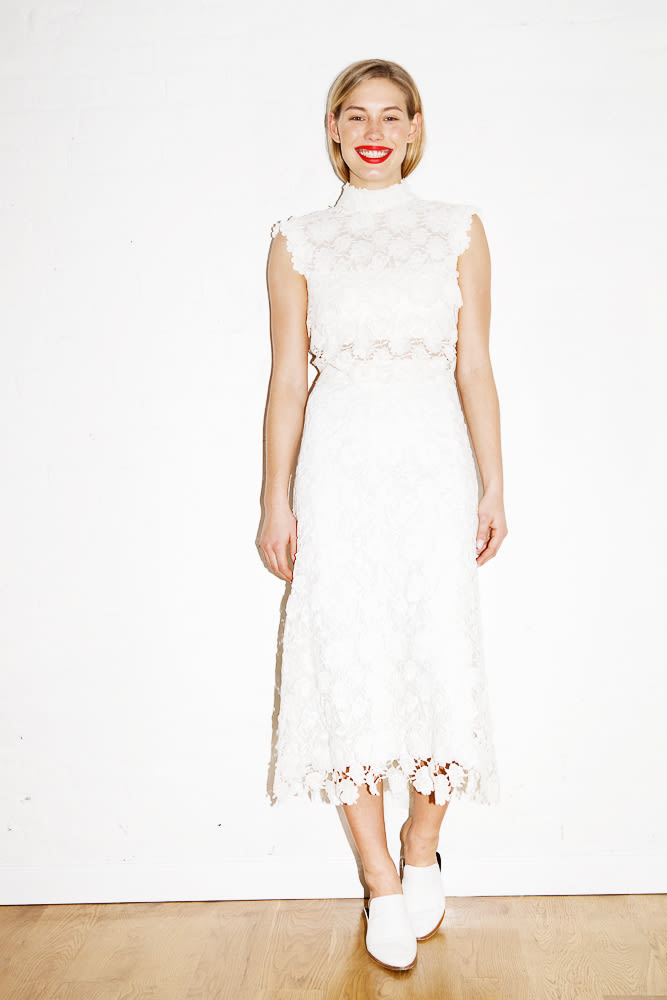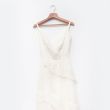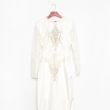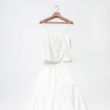One of the bigger misfortunes of today’s crop of young women is that many of their mothers were in the midst of the greater fashion existential crisis that was the ‘70s and ‘80s when they got married. Wedding dress styles ran the gamut from peasant sleeves trimmed with crocheted detailing, to layers upon layers of princess-worthy tulle sitting beneath heavy poly-blend. This is to say that the likelihood of inheriting your mother’s wedding dress and then wearing it willingly down the aisle seems ill-advised and entirely unlikely. Unless, that is, you’re sentimental, looking for a challenge, or both.
“It’s certainly more work,” Nayantara Banerjee, of the Williamsburg Seamster, said of retooling vintage dresses into functional and contemporary gowns for her bridal clients. “But it’s certainly more fulfilling.” For one thing, you emerge on the other side, one-of-a-kind dress in hand. And if you're going to wear a completely customized dress once in your life, wouldn't it make sense to do it on your wedding day?
To test this theory, ITG sent Nayantara three dresses, acquired on Etsy and various thrift stores around New York City. Aside from their obvious age, all three were in pretty good condition (wedding dresses, it’s safe to assume, are often only worn once by their original owner). But, that beading! And all those layers of tulle…
A couple weeks later, lo and behold, three beautiful dresses arrived at our office, bearing little resemblance to the original models. Two came back as sets—a crocheted dress with with a train transformed into a sheer crop top and skirt ensemble (à la Stone Fox Bride); the long-sleeved, beaded gown shed most of its synthetic material, with the beading transplanted on a new silk camisole and the crinoline surviving as a pared-down ball skirt. The third, and easiest to work with, Nayantara divulged, lost some ruffles and gained a more modern neckline, perfectly suited for a wedding on a pastoral farm. Connecticut would be nice.
“All three became more minimal—we wanted to make sure the transformation was significant but not costume-y,” she said. “Dresses from the ’70s tend to be easier to transform…a lot of them have simpler sleeves and a hippie look that works for a lot of brides right now. The issue with the ’80s dresses is that the fabric can be a little overwhelming, which is why I took the beading off and added a new camisole to that look.”
The two-piece wedding look has become something of a pervasive trend in the bridal world, she confirms, for it’s casual vibe. “There’s an ease and a comfort to it,” she says. “It really varies in personal style, but fewer of my brides are used to wearing big full floor length dresses. There’s something more approachable to two pieces that a lot of brides respond to.”
And if you find a good tailor who shares your creative vision, a dress's previous style is no object. “Almost every dress I've done for a client,” Nayantara added, “I've added sleeves to. Not so much for the modesty aspect, but for the style,” Proving that just because you don't want that voluminous cap sleeve sitting on your shoulder, doesn't mean you don't need something.
It’s also a pretty cost-effective way to approach buying your wedding dress once all is said and paid for. Each vintage dress cost around an initial $150 (less if you actually inherit it from your mother), with alterations running around $400 to $650. To compare, Nayantara estimates that her dresses, if you were to find them new in a bridal salon, could cost upwards of $2000 (that's before any custom work, too). Add that to the fact that your dress in effect becomes your “something old' and “something new' and you're knocking out all the birds with one stone. How's that for effective wedding planning?
Ulrikke Simonsen (New York Model Management) photographed by Tom Newton. To see more wedding dress transformations, visit the Williamsburg Seamster.


















